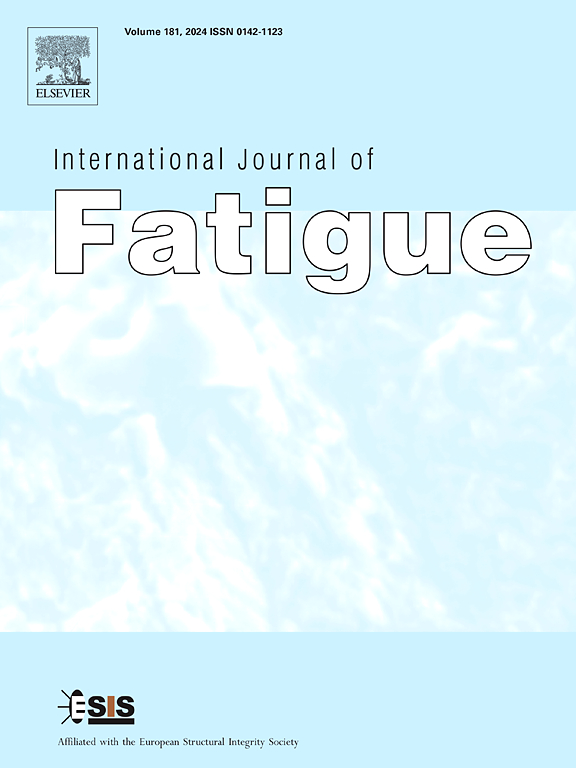基于三维数字扫描和隐式梯度模型的管状焊接接头局部疲劳增强方法
IF 6.8
2区 材料科学
Q1 ENGINEERING, MECHANICAL
引用次数: 0
摘要
海上风力涡轮机(owt)导管套结构的设计主要受疲劳驱动,这是由于作业运动、波浪和风的动态载荷所导致的。本研究旨在开发一个用于套管焊接接头疲劳分析的数字框架,通过其数字图像结合真实的3D扫描几何形状和缺陷。采用有限元法对试验结果进行了数值分析,其中采用隐式梯度模型(IGM)考虑了微支护的影响。此外,4R方法已用于解释由于残余应力和缺陷引起的平均应力修正。在高周疲劳试验中,采用数字图像相关(DIC)技术检测工艺裂纹的萌生和发展,提供应变分布和裂纹尺寸发展的精确测量。结果表明,基于IGM的数值框架可以成功地确定三维扫描焊接细部裂纹的寿命和起裂位置。提出的框架显著提高了高周疲劳寿命预测的准确性,并为结构健康监测提供了可扩展的解决方案,促进了包括建筑、汽车、航空航天和可再生能源在内的广泛行业的寿命延长。本文章由计算机程序翻译,如有差异,请以英文原文为准。
Enhanced local fatigue approach for welded tubular joints using 3D digital scans and implicit gradient model
The design of jacket structures in offshore wind turbines (OWTs) is driven by fatigue, crucial due to dynamic loads from operational movements, waves, and wind. This study aims to develop a digital framework for fatigue analysis of tubular welded joints in jacket OWT, incorporating real 3D scanned geometries and imperfections through their digital images. Numerical analysis has been conducted using finite element method to predict the experimental results, in which the effect of micro-support has been taken into account using an implicit gradient model (IGM). Furthermore, 4R method has been used to account for mean stress corrections due to residual stresses and imperfections. Digital Image Correlation (DIC) was employed during the high-cycle fatigue experiments to detect the initiation and progression of a technical crack, providing precise measurements of strain distribution and crack size development. The results have shown that the proposed numerical framework based on the IGM can successfully determine the lifetime and location of crack initiation in the 3D scanned welded details. The proposed framework significantly improves the accuracy of high-cycle fatigue life predictions and offers a scalable solution for structural health monitoring, facilitating lifetime extension across a wide range of industries, including construction, automotive, aerospace, and renewable energy.
求助全文
通过发布文献求助,成功后即可免费获取论文全文。
去求助
来源期刊

International Journal of Fatigue
工程技术-材料科学:综合
CiteScore
10.70
自引率
21.70%
发文量
619
审稿时长
58 days
期刊介绍:
Typical subjects discussed in International Journal of Fatigue address:
Novel fatigue testing and characterization methods (new kinds of fatigue tests, critical evaluation of existing methods, in situ measurement of fatigue degradation, non-contact field measurements)
Multiaxial fatigue and complex loading effects of materials and structures, exploring state-of-the-art concepts in degradation under cyclic loading
Fatigue in the very high cycle regime, including failure mode transitions from surface to subsurface, effects of surface treatment, processing, and loading conditions
Modeling (including degradation processes and related driving forces, multiscale/multi-resolution methods, computational hierarchical and concurrent methods for coupled component and material responses, novel methods for notch root analysis, fracture mechanics, damage mechanics, crack growth kinetics, life prediction and durability, and prediction of stochastic fatigue behavior reflecting microstructure and service conditions)
Models for early stages of fatigue crack formation and growth that explicitly consider microstructure and relevant materials science aspects
Understanding the influence or manufacturing and processing route on fatigue degradation, and embedding this understanding in more predictive schemes for mitigation and design against fatigue
Prognosis and damage state awareness (including sensors, monitoring, methodology, interactive control, accelerated methods, data interpretation)
Applications of technologies associated with fatigue and their implications for structural integrity and reliability. This includes issues related to design, operation and maintenance, i.e., life cycle engineering
Smart materials and structures that can sense and mitigate fatigue degradation
Fatigue of devices and structures at small scales, including effects of process route and surfaces/interfaces.
 求助内容:
求助内容: 应助结果提醒方式:
应助结果提醒方式:


